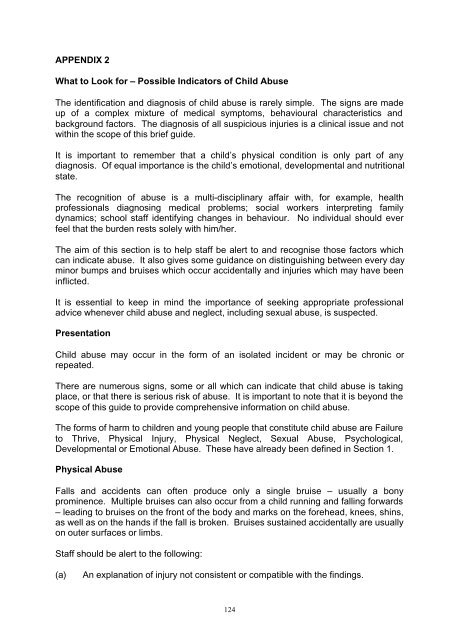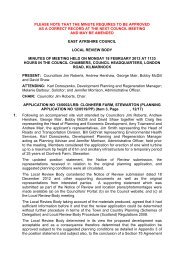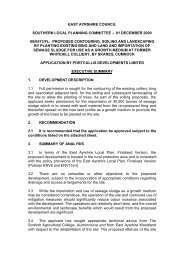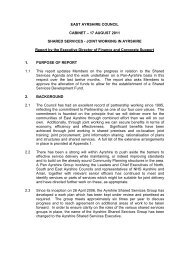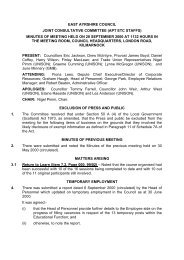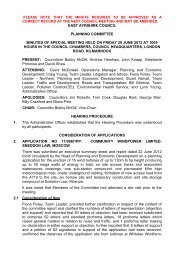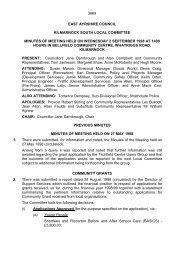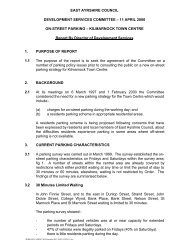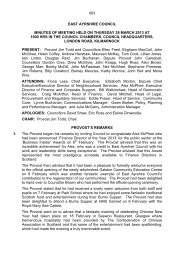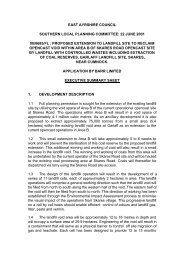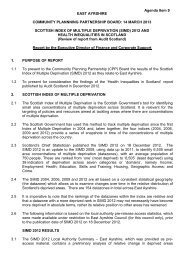Child Protection Procedures - East Ayrshire Council
Child Protection Procedures - East Ayrshire Council
Child Protection Procedures - East Ayrshire Council
You also want an ePaper? Increase the reach of your titles
YUMPU automatically turns print PDFs into web optimized ePapers that Google loves.
APPENDIX 2<br />
What to Look for – Possible Indicators of <strong>Child</strong> Abuse<br />
The identification and diagnosis of child abuse is rarely simple. The signs are made<br />
up of a complex mixture of medical symptoms, behavioural characteristics and<br />
background factors. The diagnosis of all suspicious injuries is a clinical issue and not<br />
within the scope of this brief guide.<br />
It is important to remember that a child’s physical condition is only part of any<br />
diagnosis. Of equal importance is the child’s emotional, developmental and nutritional<br />
state.<br />
The recognition of abuse is a multi-disciplinary affair with, for example, health<br />
professionals diagnosing medical problems; social workers interpreting family<br />
dynamics; school staff identifying changes in behaviour. No individual should ever<br />
feel that the burden rests solely with him/her.<br />
The aim of this section is to help staff be alert to and recognise those factors which<br />
can indicate abuse. It also gives some guidance on distinguishing between every day<br />
minor bumps and bruises which occur accidentally and injuries which may have been<br />
inflicted.<br />
It is essential to keep in mind the importance of seeking appropriate professional<br />
advice whenever child abuse and neglect, including sexual abuse, is suspected.<br />
Presentation<br />
<strong>Child</strong> abuse may occur in the form of an isolated incident or may be chronic or<br />
repeated.<br />
There are numerous signs, some or all which can indicate that child abuse is taking<br />
place, or that there is serious risk of abuse. It is important to note that it is beyond the<br />
scope of this guide to provide comprehensive information on child abuse.<br />
The forms of harm to children and young people that constitute child abuse are Failure<br />
to Thrive, Physical Injury, Physical Neglect, Sexual Abuse, Psychological,<br />
Developmental or Emotional Abuse. These have already been defined in Section 1.<br />
Physical Abuse<br />
Falls and accidents can often produce only a single bruise – usually a bony<br />
prominence. Multiple bruises can also occur from a child running and falling forwards<br />
– leading to bruises on the front of the body and marks on the forehead, knees, shins,<br />
as well as on the hands if the fall is broken. Bruises sustained accidentally are usually<br />
on outer surfaces or limbs.<br />
Staff should be alert to the following:<br />
(a)<br />
An explanation of injury not consistent or compatible with the findings.<br />
124


